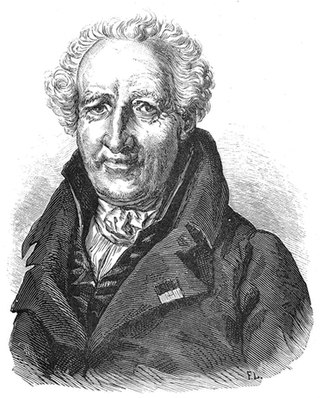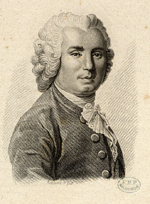Related Research Articles

Antoine-Laurent de Lavoisier, also Antoine Lavoisier after the French Revolution, was a French nobleman and chemist who was central to the 18th-century chemical revolution and who had a large influence on both the history of chemistry and the history of biology.

Antoine Laurent de Jussieu was a French botanist, notable as the first to publish a natural classification of flowering plants; much of his system remains in use today. His classification was based on an extended unpublished work by his uncle, the botanist Bernard de Jussieu.

Antoine François Fourcroy was a French chemist and a contemporary of Antoine Lavoisier. Fourcroy collaborated with Lavoisier, Guyton de Morveau, and Claude Berthollet on the Méthode de nomenclature chimique, a work that helped standardize chemical nomenclature.
The year 1787 in science and technology involved some significant events.
The year 1826 in science and technology involved some significant events, listed below.
The year 1771 in science and technology involved some significant events.
The year 1776 in science and technology involved some significant events.
The year 1728 in science and technology involved some significant events.
The year 1797 in science and technology involved some significant events.

Henri Ernest Baillon was a French botanist and physician. He was born in Calais on 30 November 1827 and died in Paris on 19 July 1895.

Samuel Auguste André David Tissot was a notable 18th-century Swiss physician.

Antoine Louis was an 18th-century French surgeon and physiologist.
Raoul Bensaude was a French-Portuguese physician born in the Azores of Portuguese-Jewish descent.

Paul Jacques Malouin was a French physician and chemist.
The Commission des Sciences et des Arts was a French scientific and artistic institute. Established on 16 March 1798, it consisted of 167 members, of which all but 16 joined Napoleon Bonaparte's campaign in Egypt and produced the Description de l'Égypte. More than half were engineers and technicians, including 21 mathematicians, 3 astronomers, 17 civil engineers, 13 naturalists and mining engineers, geographers, 3 gunpowder engineers, 4 architects, 8 artists, 10 mechanical artists, 1 sculptor, 15 interpreters, 10 men of letters, 22 printers in Latin, Greek and Arabic characters. Bonaparte organised his scientific 'corps' like an army, dividing its members into 5 categories and assigning to each member a military rank and a defined military role beyond his scientific function.

Debauve & Gallais is a French chocolate manufacturer founded by Sulpice Debauve in 1800. After his nephew Antoine Gallais joined the company in 1823, the company adopted their current name. In 1819 the company received the royal warrant as purveyors to the French court, and was the official chocolate supplier for Emperor Napoleon and of kings Louis XVIII, Charles X and Louis Philippe.
Jean-Baptiste-Michel Bucquet was a French chemist, member of the French Royal Academy of Sciences, physician and public teacher.

Théophile de Bordeu was a French physician.

Louis Lépecq de La Clôture was a French surgeon and epidemiologist. His work consisted mainly of a 15-year observation of the relations between climate, geography and pathologies in Normandy.
Pierre Amable Jean-Baptiste Trannoy was a French physician, hygienist and botanist.
References
- ↑ "Lavoisier, Antoine." Encyclopædia Britannica. 2007. Encyclopædia Britannica Online. 24 July 2007 .
- ↑ Weisstein, Eric W. (1996). "Lavoisier, Antoine (1743–1794)". Eric Weisstein's World of Scientific Biography. Wolfram Research Products. Retrieved 2007-02-23.
- ↑ Collingridge, Vanessa (2003). Captain Cook: The Life, Death and Legacy of History's Greatest Explorer. London: Ebury Press. ISBN 0-09-188898-0.
- ↑ Cook, Andrew S. (2004). "Rennell, James (1742–1830)" . Oxford Dictionary of National Biography (online ed.). Oxford University Press. doi:10.1093/ref:odnb/23369 . Retrieved 2011-04-05.(Subscription or UK public library membership required.)
- ↑ Karbowski, K. (April 1986). "Samuel Auguste Tissot: his research on migraine". Journal of Neurology . 233 (2): 123–125. doi:10.1007/BF00313859. ISSN 0340-5354. PMID 3517238. S2CID 24691943.
- ↑ Pearce, J.M.S. (September 2000). "Samuel-Auguste Tissot (1728-1797) and migraine". Cephalalgia . 20 (7). Norway: 668–70. doi:10.1111/j.1468-2982.2000.00100.x. ISSN 0333-1024. PMID 11128826. S2CID 36466035.
- ↑ Lépecq de La Cloture, Louis (1778). Collection d'observations sur les maladies et constitutions épidémiques: ouvrage qui expose une suite de quinze années d'observations, & dans lequel les épidémies, les constitutions régnantes & intercurrentes, sont liées (partie I) (in French). Rouen: Imprimerie privilégiée. Retrieved 28 February 2021.
- ↑ Lépecq de La Cloture, Louis (1778). Collection d'observations sur les maladies et constitutions épidémiques: ouvrage qui expose une suite de quinze années d'observations, & dans lequel les épidémies, les constitutions régnantes & intercurrentes, sont liées (partie II,III et IV) (in French). Rouen: Imprimerie privilégiée. Retrieved 28 February 2021.
- ↑ Williams, Hywel (2005). Cassell's Chronology of World History . London: Weidenfeld & Nicolson. pp. 331–332. ISBN 0-304-35730-8.
- ↑ Troyano, Leonardo Fernández (2003). Bridge Engineering: a Global Perspective. London: Thomas Telford Publishing. pp. 158–9. ISBN 0-7277-3215-3 . Retrieved 2011-08-16.
- ↑ Tuxen, S. L. (1967). "The entomologist J. C. Fabricius". Annual Review of Entomology . 12: 5. doi:10.1146/annurev.en.12.010167.000245.
one of the most important books in entomology of all times
- ↑ "Copley Medal | British scientific award". Encyclopedia Britannica. Retrieved 21 July 2020.